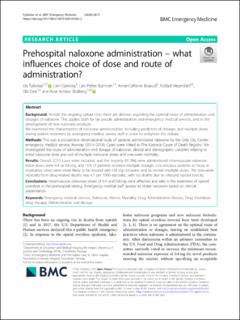| dc.contributor.author | Tylleskär, Ida | |
| dc.contributor.author | Gjersing, Linn | |
| dc.contributor.author | Bjørnsen, Lars Petter Bache-Wiig | |
| dc.contributor.author | Braarud, Anne-Cathrine | |
| dc.contributor.author | Heyerdahl, Fridtjof | |
| dc.contributor.author | Dale, Ola | |
| dc.contributor.author | Skulberg, Arne Kristian | |
| dc.date.accessioned | 2020-09-08T06:40:47Z | |
| dc.date.available | 2020-09-08T06:40:47Z | |
| dc.date.created | 2020-09-03T21:43:24Z | |
| dc.date.issued | 2020 | |
| dc.identifier.issn | 1471-227X | |
| dc.identifier.uri | https://hdl.handle.net/11250/2676758 | |
| dc.description.abstract | Background
Amidst the ongoing opioid crisis there are debates regarding the optimal route of administration and dosages of naloxone. This applies both for lay people administration and emergency medical services, and in the development of new naloxone products.
We examined the characteristics of naloxone administration, including predictors of dosages and multiple doses during patient treatment by emergency medical service staff in order to enlighten this debate.
Methods
This was a prospective observational study of patients administered naloxone by the Oslo City Center emergency medical service, Norway (2014–2018). Cases were linked to The National Cause of Death Registry. We investigated the route of administration and dosage of naloxone, clinical and demographic variables relating to initial naloxone dose and use of multiple naloxone doses and one-week mortality.
Results
Overall, 2215 cases were included, and the majority (91.9%) were administered intramuscular naloxone. Initial doses were 0.4 or 0.8 mg, and 15% of patients received multiple dosages. Unconscious patients or those in respiratory arrest were more likely to be treated with 0.8 mg naloxone and to receive multiple doses. The one-week mortality from drug-related deaths was 4.1 per 1000 episodes, with no deaths due to rebound opioid toxicity.
Conclusions
Intramuscular naloxone doses of 0.4 and 0.8 mg were effective and safe in the treatment of opioid overdose in the prehospital setting. Emergency medical staff appear to titrate naloxone based on clinical presentation. | en_US |
| dc.language.iso | eng | en_US |
| dc.publisher | BMC (part of Springer Nature) | en_US |
| dc.rights | Navngivelse 4.0 Internasjonal | * |
| dc.rights.uri | http://creativecommons.org/licenses/by/4.0/deed.no | * |
| dc.title | Prehospital naloxone administration – what influences choice of dose and route of administration? | en_US |
| dc.type | Peer reviewed | en_US |
| dc.type | Journal article | en_US |
| dc.description.version | publishedVersion | en_US |
| dc.source.journal | BMC Emergency Medicine | en_US |
| dc.identifier.doi | 10.1186/s12873-020-00366-3 | |
| dc.identifier.cristin | 1827232 | |
| dc.description.localcode | © The Author(s). 2020 Open Access This article is licensed under a Creative Commons Attribution 4.0 International License, which permits use, sharing, adaptation, distribution and reproduction in any medium or format, as long as you give appropriate credit to the original author(s) and the source, provide a link to the Creative Commons licence, and indicate if changes were made. The images or other third party material in this article are included in the article's Creative Commons licence, unless indicated otherwise in a credit line to the material. If material is not included in the article's Creative Commons licence and your intended use is not permitted by statutory regulation or exceeds the permitted use, you will need to obtain permission directly from the copyright holder. To view a copy of this licence, visit http://creativecommons.org/licenses/by/4.0/. The Creative Commons Public Domain Dedication waiver (http://creativecommons.org/publicdomain/zero/1.0/) applies to the data made available in this article, unless otherwise stated in a credit line to the data. | en_US |
| cristin.ispublished | true | |
| cristin.fulltext | original | |
| cristin.qualitycode | 1 | |

